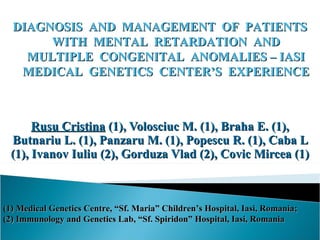Rusu Cristina Rm B Rare Cluj
- 1. DIAGNOSIS AND MANAGEMENT OF PATIENTS WITH MENTAL RETARDATION AND MULTIPLE CONGENITAL ANOMALIES ŌĆō IASI MEDICAL GENETICS CENTERŌĆÖS EXPERIENCE Rusu Cristina (1), Volosciuc M. (1), Braha E. (1), Butnariu L. (1), Panzaru M. (1), Popescu R. (1), Caba L (1), Ivanov Iuliu (2), Gorduza Vlad (2), Covic Mircea (1) (1) Medical Genetics Centre, ŌĆ£Sf. MariaŌĆØ ChildrenŌĆÖs Hospital, Iasi, Romania; (2) Immunology and Genetics Lab, ŌĆ£Sf. SpiridonŌĆØ Hospital, Iasi, Romania
- 2. MENTAL RETARDATION ŌĆō DEFINITIONS ’ā╝ Mental retardation (MR) = QI < 70; ’ā╝ Prevalence: 3%; Mild MR - 7-10 x more frequent than moderate/ severe MR; ’ā╝ Evaluation supposes gathering information from specialists (educator, psychologist, physician) + parents; ’ā╝ Classification: ŌŚ” Mild (IQ 50-70) ŌĆō 85%; ŌŚ” Moderate (IQ 35-50) ŌĆō 10%; ŌŚ” Severe (IQ 20-35); ŌŚ” Profound (IQ <20); 13/07/09 2
- 3. MENTAL RETARDATION ŌĆō DETERMINISM ’ā╝ Variable according to MR severity; ’ā╝ Mild MR: o Environment ŌĆō 75-90% (social factors !); o Genetic factors ŌĆō 10-25%; ’ā╝ Severe MR: o Environment ŌĆō 50%; o Genetic factors ŌĆō 50% (monogenic/ multifactorial disorders/ chromosomal abnormalities). 13/07/09 3
- 4. MODERATE / SEVERE M.R. ŌĆō GENETIC CAUSES ’ü▒ CHROMOSOMAL ABNORMALITIES: ŌŚ” Numerical: trisomy 21, 13, 18, Klinefelter ŌåÆ karyotype; ŌŚ” Structural: ’é¢ Deletions/ duplications: 4p-, 5p- ŌåÆ karyotype; ’é¢ Microdeleions/ duplications: Sdr Williams, Prader Willi, Angelman ŌåÆ FISH; ’é¢ Subtelomeric rearrangements ŌåÆ MLPA; ’ü▒ MONOGENIC DISORDERS: ŌŚ” X-linked mental retardation: Fragile X syndrome ŌåÆ DNA test (PCR, Southern blot); ŌŚ” Metabolic disorders: Lesch Nyhan, Menkes ŌåÆ biochemical test. ŌŚ” POLYGENIC CAUSES ŌŚ” MITOCHONDRIAL DISORDERS 13/07/09 4
- 5. MATERIAL AND METHOD ’üĮ We have designed, optimized and applied an investigation protocol for mentally retarded individuals; the protocol: ŌĆó Covers most genetic causes of moderate/ severe MR; ŌĆó Adapted to our lab (equipments/ cost of the reagents); ’üĮ We have taken 200 mentally retarded patients examined in Iasi Medical Genetics Center and analyzed the efficiency of the protocol: ŌĆó If De Vries score (proposed for subtelomeric rearrangementsŌĆÖ identification) could be used broadly for chromosomal abnormalities detection; ŌĆó If the results provided by screening methods (antiFMRP test and MLPA) are concordant with diagnostic tests (long range PCR and FISH); ŌĆó If the methods chosen are reliable;
- 6. PROTOCOL OPTIMIZATION ’üĮ Use selection scores, so that the percent of positive tests will be good enough; ’üĮ Choose the cheapest, less dangerous method that provides good results; ’üĮ Use a sequence of reactions: first screening tests and then diagnostic tests, so that the abnormality will be identified precisely in the end; ’üĮ Reducing the cost by reducing the amount of reagents used;
- 7. CLINICAL PROTOCOL ’üĮ PERSONAL HISTORY (pre/intra/postnatal ŌåÆ exclude MR produced by the environment); ’üĮ Extended FAMILY HISTORY ŌåÆ pedigree; ’üĮ ANTHROPOMETRIC MEASUREMENTS (Ht, Wt, HC, others); ’üĮ Detailed PHYSICAL EXAMINATION (+ photos); ’üĮ PSYCHOLOGIC EVALUATION; EVALUATION ’üĮ DE VRIES SCORE for case selection; ’üĮ TEST the child with MR ŌåÆ anomalies identified ŌåÆ test the parents; ’üĮ GENETIC COUNSELLING (before test, followed by written consent of the parents; new session when test results were available); ’üĮ Data recorded in a DATABASE specially designed;
- 8. DE VRIES SCORE (2001): 3/> points necessary Criteria Score Mental retardation family history ŌĆó Compatible with monogenic inheritance 1 ŌĆó Incompatible with monogenic inheritance (including discordant phenotypes) 2 Prenatal onset growth retardation 2 Abnormal postnatal growth (1 point each, maximum 2 points) ŌĆó Microcephaly 1 ŌĆó Short stature 1 ŌĆó Macrocephaly 1 ŌĆó Tall stature 1 2/> facial anomalies (mostly hypertelorism, nasal and auricular defects) 2 Extrafacial anomalies (1 point each, maximum 2 points), especially: ŌĆó Hand anomalies 1 ŌĆó Heart defects 1 ŌĆó Hypospadias +/- criptorchydism 1
- 9. INVESTIGATION PROTOCOL ’üĮ KARYOTYPE (ŌåÆ numerical & structural chromosomal abnormalities); ’üĮ BARR TEST ŌĆō for cases that associate abnormal sexual development; ’üĮ Fragile X screening and diagnosis ŌĆō done for cases with speech delay/ autism (early signs of Fragile X); positive & negative samples included; ŌŚ” ANTI-FMRP TEST (immunohistochemical test done on hair root) ŌåÆ screening; ŌŚ” Long range PCR (identifies premutations and complete mutations) ŌåÆ diagnostic; ’üĮ MLPA (2 separate kits P036 and P070) ŌåÆ subtelomeric rearrangements (if the results in both kits are abnormal) and polymorphisms (if the result is abnormal in a single kit); ’üĮ FISH ŌåÆ microdeletions / confirm subtelomeric rearrangements; ’üĮ DNA stored for subsequent tests (after parental consent);
- 10. RESULTS ’üĮ 53% of patients (106) have been selected for genetic testing; the rest were due to social causes/ perinatal events/ fetopathies etc; ’üĮ 4 patients had specific monogenic disorders and a DNA sample has been taken for further confirmation; ’üĮ 15 patients had a Barr test ŌåÆ 3 cases confirmed; ’üĮ 99 patients had a karyotype ŌåÆ 43 cases identified; many of them were Down syndrome; ’üĮ 7 patients had a FISH test for microdeletion ŌåÆ 1 case confirmed; ’üĮ 55 patients had a MLPA test ŌåÆ 4 cases identified; FISH confirmation is in due course; ’üĮ 8 patients had FraX testing ŌåÆ all normal; ’üĮ Structural chromosomal abnormalities identified by karyotype have been confirmed by MLPA.
- 11. TEST EFFICIENCY 100% 90% 80% 70% 60% 50% Abnormal Normal 40% 30% 20% 10% 0% Barr Kar FISH MLPA FraX
- 14. 0 0.2 0.4 0.6 0.8 1 1.2 1.4 1.6 1.8 2 0 0.2 0.4 0.6 0.8 1 1.2 1.4 1.6 1.8 2 01-001.2 SCNN1D 01-001.0 TNFRSF18 01-247.1 SH3BP5L 02-000.3 ACP1 02-000.3 ACP1 02-241.2 CAPN10 03-000.3 CHL1 03-000.3 CHL1 03-198.8 BDH1 04-000.5 GPI7 04-000.3 ZNF141 04-191.1 FRG1 05-000.3 PDCD6 05-000.3 LOC133957 05-180.6 GNB2L1 06-000.3 IRF4 06-000.3 IRF4 06-170.7 PSMB1 07-000.9 CENTA1 07-000.9 UNC84A 07-158.6 VIPR2 08-000.4 FBXO25 08-000.4 FBXO25 08-144.6 ZC3H3 09-000.9 DMRT1 09-000.4 DOCK8 09-139.8 EHMT1 10-000.5 DIP2C 10-000.2 ZMYND11 10-135.0 PAOX 11-000.2 RIC8A 11-000.2 BET1L 11-133.6 hCAP-D3 12-000.12 SLC6A12 12-000.3 JARID1A 12-132.2 ZNF10 Mapview 13-019.2 PSPC1 Mapview 13-019.2 PSPC1 13-112.8 F7 14-019.9 CCNB1IP1 14-019.9 PARP2 po36-88.D04_08121819RL^CEQsCSV.csv 14-105.0 MTA1 15-021.5 NDN 15-021.4 MKRN3 15-099.3 ALDH1A3 P070.88.G01_09032408H9^CEQsCSV.csv 16-000.4 DECR2 16-000.04 POLR3K 16-088.6 GAS8 17-000.1 RPH3AL 17-000.1 RPH3AL 17-078.4 TBCD 18-000.2 THOC1 18-000.2 USP14 18-075.9 C18orf22 19-000.2 PPAP2C 19-000.5 CDC34 19-063.8 CHMP2A 20-000.2 ZCCHC3 20-000.3 SOX12 20-062.2 OPRL1 21-014.7 STCH 21-014.5 RBM11 21-046.9 HRMT1L1 DUPLICATION 9p 22-016.0 IL17R 22-016.6 BID 22-049.6 RABL2B X-000.5 SHOX X/Y-000.5 SHOX (PAR region) X/Y-154.8 SYBL1 (PAR region)
- 16. Ratio 0 0.2 0.4 0.6 0.8 1 1.2 1.4 1.6 01-001.0 TNFRSF18 02-000.3 ACP1 03-000.3 CHL1 04-000.3 ZNF141 5-000.3 LOC133957 06-000.3 IRF4 07-000.9 UNC84A 08-000.4 FBXO25 09-000.4 DOCK8 10-000.2 ZMYND11 11-000.2 BET1L 12-000.3 JARID1A 13-019.2 PSPC1 14-019.9 PARP2 15-021.5 NDN P070.111.H01_09032408HA^CEQsCSV.csv 16-000.4 DECR2 17-000.1 RPH3AL 18-000.2 THOC1 19-000.2 PPAP2C 20-000.2 ZCCHC3 21-014.7 STCH 22-016.0 IL17R dup(21)(q22.3;q11.2) X-000.5 SHOX
- 17. CONCLUSIONS ’üĮ De Vries score - useful for case selection (both chromosomal abnormalities and subtelomeric rearrangements); ’üĮ MLPA - reliable, fast and unexpensive method that can be used as a screening method for subtelomeric rearrangements; ’üĮ MLPA may be used as a complementary method to identify marker chromosomes/ complex chromosomal abnormalities; ’üĮ The protocol could be further optimized by extending MLPA for other applications; ’üĮ Cases with normal results/ polymorphisms - reevaluated in order to get a final diagnosis; ’üĮ Cases identified - followed in order to prevent complications; clinical description of subtelomeric rearrangements is an ongoing process.
- 18. 13/07/09 18

































































